What is Matter? It doesn't matter if you don't know Matter...In the article, we will explore Matter protocol further, which is a new future of smart home.
Birth of Matter protocol
Since the end of 2019, the hot topic in the IoT industry is Matter protocol which is called Project Connected Home over IP (shorted by Project CHIP). Project CHIP is a work group that was initiated and built by Google, Amazon, Apple, and the ZigBee Alliance. This group is based on the Internet Protocol (IP) to create a smart home protocol standard that can realize the interoperability of different protocols, increase compatibility among smart home products, and provide a seamless user experience to make our lives easier.
Until May 2021, the ZigBee Alliance established in 2002 was renamed CSA (Connectivity Standard Alliance). Literally, it is an alliance related to connection standards. It sounds more domineering, like a family bucket. Then, the Connected Home over IP protocol was renamed Matter, which is the “Matter” from “it doesn't Matter”.
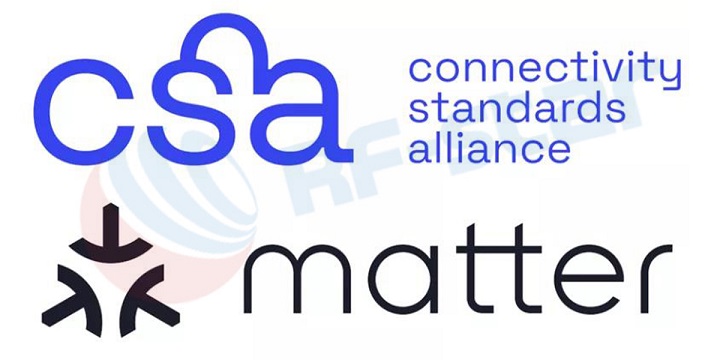
The CSA puts the Matter protocol in the top, which shows the status of Matter and its popularity.

With the release of Matter protocol development plan, the working group works overtime, and the pace of issuing has become increasingly tight. There are still many problems in need of our in-depth analysis:
What changes will Matter protocol bring to the existing IoT communication protocol in smart home?
The communication protocols used in existing smart home IoT products are also diverse, and each wireless technology has its characteristics and applications.

Since Matter is a protocol related to IoT communication, and mainly used at the application layer protocol, will it affect the development of these protocols, especially the landing of products using these protocol technologies? The answer is yes. From the current Matter working group, the first round of protocols discussed and supported are Wi-Fi, Thread, ZigBee, and Bluetooth.
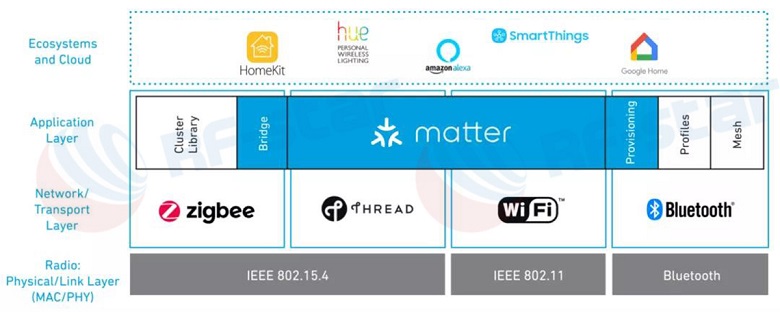
Will Wi-Fi based on the IP protocol be popular again?
As one of the most popular communication protocols in the IoT applications, Wi-Fi will benefit from the birth of Matter protocol again. On one side, Wi-Fi is a technology based on IP protocol from the beginning, and can directly support Matter naturally. On the other hand, Wi-Fi has been short of unified protocol at the application layer, especially at the business level of the smart home industry. Although we are familiar with application layer protocols widely used in Internet of things applications such as HTTP, COAP, and MQTT, they are all standards at the communication level.
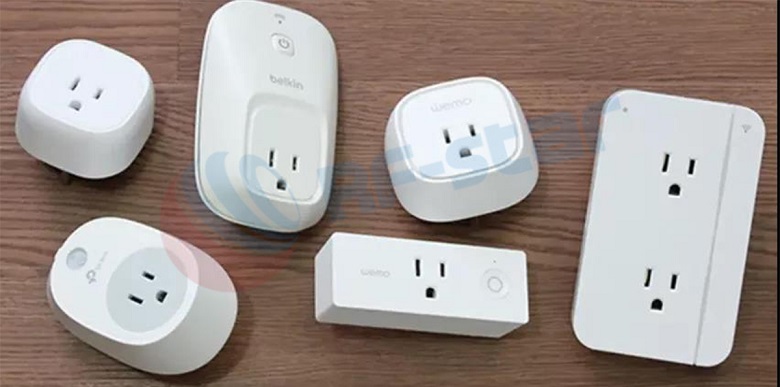
When IoT Wi-Fi products were just launched, smart plugs have become the most popular products. Meanwhile, some problems also appeared to the public.
If a user want to adpot the smart plug produced by each manufacturer, he/she has to install a specific mobile app that will match up the smart device. The function of each smart device is similar, but there are too many apps installed on the mobile phone, and the communication protocol used by each manufacturer and the business data format defined on the protocol are totally different. So, talking about interoperability is even more difficult.
Now with the support of the Matter protocol, the application business is unified, making it possible to interoperate between Wi-Fi-based smart home products. What's more powerful is that Wi-Fi products can also interoperate with other wireless technology products, making Wi-Fi products smarter.
Will Thread protocol application have an explosive growth?
You may haven’t heard of the Thread protocol before. In fact, it was born in 2014. The Thread protocol was developed by Google Nest Labs. When I read the Thread protocol standard for the first time, I was excited because of the advancement and practicality of many technical points. For example, especially compared to ZigBee and Z-wave, no decentralized mesh network of single-point-of-failure, easy to access the Internet based on the IPv6 protocol, high-level security standards, better compatibility guarantees with Open Source Stack, more device roles, and other features. Perhaps these are the reasons why many foreign giants have joined the Thread Alliance. However, the technical advantages did not help Thread to quickly implement productization. Thread products of some manufacturers can be found in foreign countries, and there are few in China.
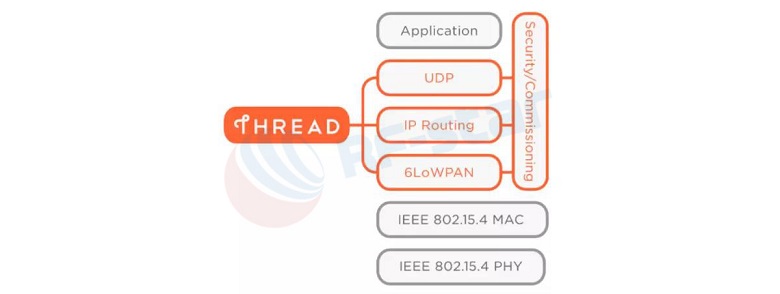
The reason is also Thread protocol's lack of uniform standards at the application layer. Although there is also application layer support such as Google Weave, there is still a lack of strong promotion. Nowadays, the support of Matter protocol can be regarded as having the shortcut of the application layer to the Thread protocol, and it is the shortcut recognized by the major giants. Thread can take advantage of IP-based advantages to easily access the Matter network to achieve interoperability with other products.
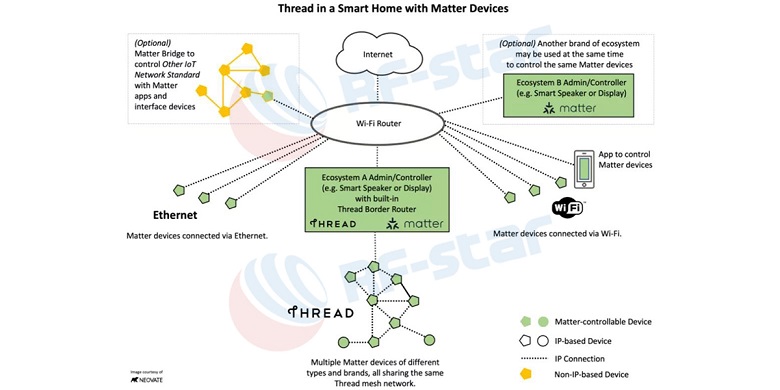
So it seems that the Thread protocol can be perfectly applied to the smart home system, and it may challenge ZigBee, Z-wave, and other protocols in the smart home. With the support of Google Home, Amazon Echo, and Apple Home Pod, they will definitely accelerate the access of Thread single-category products. So, there is a possibility that the Thread protocol application will develop faster in overseas countries, but it may take a longer time in China because the key is the ecosystem. For example, B-end hardcover housing market, which is widely used in smart home so far, almost adopts the ZigBee protocol as an industry standard.
Can ZigBee products move into a single product era?
Manufacturers or developers who are familiar with ZigBee often treat ZigBee as a system technology. They think ZigBee product is quite different from single-category products such as Wi-Fi and Bluetooth. Once the system is mentioned, the high complexity of the system, the difficulty of landing, and the high barriers to entry will come to mind. But for ZigBee, its ultimate goal is to be a single-category product that can be accepted by consumers. Like WiFi and Bluetooth products, ZigBee products bought from IKEA, Amazon, and Taobao can be used immediately after power-on. ZigBee protocol is born with a complete protocol definited from the physical layer to the application layer, and with high interoperability. This is why CSA Alliance (formerly ZigBee Alliance) can lead the development of Matter with several giants.

Once again, Matter protocol provides the possibility of single-product ZigBee products, and it can broaden a wider range of interoperability. The ZigBee device is connected to the Matter Network through the ZigBee-to-Matter bridge and interoperates with other devices that support the Matter protocol. Currently, the interoperability between mature ZigBee 3.0 devices will give a guarantee for standardized access to the Matter network.
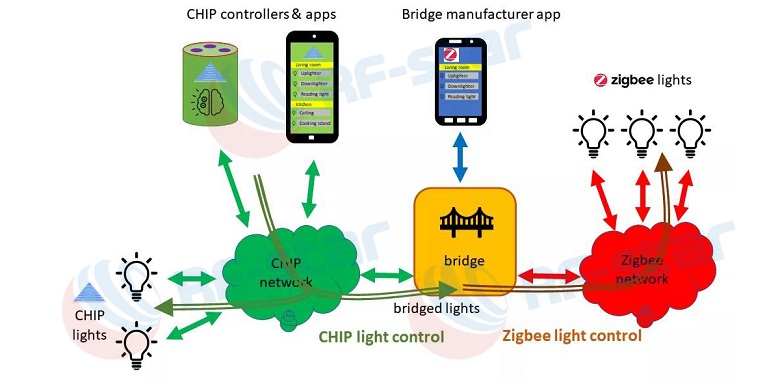
Do Chinese IoT manufacturers break the deadlock and take an aggressive action?
Since the establishment of the CHIP, these giants such as Amazon, Google, and Apple have made up their minds to make the smart home cake bigger. In the beginning, the giants put out their high technologies. Google’s Weave, Amazon’s Alexa, Apple’s HomeKit, and ZigBee’s Dotdot invested in the formulation and development of the new protocol. Later, the giants invested a lot of human resources in the CHIP working group. Different teams played an important role to push the development of the new protocol. By the end of May, more than 180 companies and over 1,700 engineers from these companies have worked hard for this goal. Of course, most of them are foreign manufacturers, and lots of IoT manufactures in China also have taken an aggressive action. From the formulation of protocol standards for the Internet of Things to the landing of final products, chip manufacturers often play a key role in the upstream of the industrial chain. Let's take a look at the new actions of Chinese chip manufacturers.
In qualità di uno dei maggiori fornitori di chip Wi-Fi IoT, Espressif ha una vasta gamma di clienti all'estero, in particolare nei circoli open-source e geek. La tecnologia Espressif sfrutta la tendenza a partecipare al piano Matter, che aiuta anche Espressif a passare rapidamente dal campo Wi-Fi originale ad altri protocolli IoT. All'inizio di agosto, Espressif ha rilasciato un chip ESP32-H2 che supporta gli standard IEEE 802.15.4 e Bluetooth LE v5.2 per supportare completamente il protocollo Matter. Riteniamo che si concentrerà su Wi-Fi, Thread e Wi-Fi + Thread (router di bordo) per soddisfare le esigenze dei clienti in Cina.
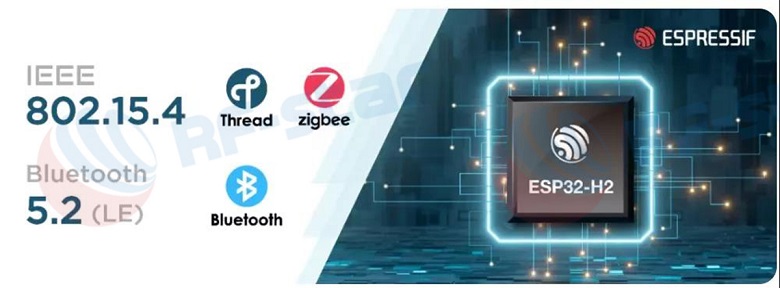
PHY+ Microelectronics si è già concentrata sullo sviluppo di chip Bluetooth a bassa potenza. Quando è stato lanciato il suo chip Bluetooth di prima generazione PHY6212, sul mercato si vociferava che la Cina avesse finalmente un chip Bluetooth domestico che potesse essere confrontato con chip Bluetooth europei e americani. Questa volta, PHY+ Microelectronics ha lanciato ancora una volta il chip dual-mode PHY6226, BLE+IEEE 802.15.4. Al momento, le piattaforme della serie PHY62xx sono anche le prime a completare la certificazione della piattaforma di compatibilità ZigBee di CSA Alliance.

Crediamo a PHY e concordiamo anche sul fatto che il protocollo Matter promosso dai colossi possa portare maggiori opportunità. Quando si tratta dell'architettura del chip PHY6226, può essere descritto come "breve e potente". Si dice che il chip sia perfetto per essere utilizzato nei prodotti terminali IoT esistenti. Yang Zhongqi, direttore del centro di ricerca e sviluppo del software di microelettronica PHY +, ha anche affermato che al momento la coesistenza di più protocolli nella casa intelligente sarà molto normale. La formulazione del protocollo Matter offrirà maggiori opportunità ai prodotti standard ZigBee 3.0. PHY ha realizzato un ricco piano di roadmap di prodotti per ZigBee, Thread, BLE e altre tecnologie. Allo stesso tempo, PHY potenzierà altri prodotti tecnologici con una vasta esperienza in Bluetooth, come ZigBee Direct, BLE Provisioning in Matter,PHY creerà chip AIOT multimodali per soddisfare le richieste del mercato e aiutare i clienti ad accelerare l'implementazione del prodotto.
Come stella nascente dei chip Wi-Fi IoT, Bouffalo Lab è stata riconosciuta dai principali clienti di elettrodomestici, illuminazione e altri mercati per le sue eccellenti prestazioni nell'odierno mercato delle applicazioni di chip Wi-Fi domestico del Mar Rosso. Successivamente, il chip BL702, che è anche il chip combinato di BLE5.0 + IEEE 802.15.4, e il precedente chip Wi-Fi sono senza dubbio rivettati per il supporto Matter. Dal punto di vista dell'architettura del chip BL702, si può dire che sia un vero e proprio chip bucket per famiglie. Rispetto ad altri tradizionali chip dual-mode, ha funzioni sia immaginabili che inaspettate. Credo che Bouffalo Lab si concentrerà anche sul Wi-Fi e sul thread sulla Materia per entrare nell'ecologia della Materia straniera e accedere alla rete della Materia attraverso un unico prodotto.

Recentemente, attraverso diversi provider IP IEEE802.15.4 e BLE tradizionali, abbiamo appreso che anche altre società cinesi di semiconduttori stanno consultando l'integrazione IP correlata nei chip esistenti, sperando di ottenere una quota del futuro mercato della Materia.
I fornitori di prodotti terminali si stanno concentrando sui primi dividendi di Matter?
Questi prodotti per la casa intelligente dei produttori di terminali IoT in Cina si stanno sviluppando così velocemente da sorprendere gli stranieri. Tutti sperano di introdurre rapidamente i prodotti Matter in una vasta gamma di mercato. Per la maggior parte dei produttori di terminali, ora puoi entrare nella fase di preparazione per conoscere Matter. Puoi seguire l'aggiornamento del codice su Github (https://github.com/project-chip/connectedhomeip), che può essere basato sull'attuale supporto Costruisci alcune demo di dispositivi hardware. Dopotutto, l'SDK open source Matter ufficiale sarà alla fine del 2021 e la versione 1.0 della specifica dovrebbe essere rilasciata all'inizio del 2022. Solo allora ci sarà uno standard di protocollo, un ambiente di sviluppo e una certificazione relativamente completi. garanzia di prova. E i produttori di chip a monte devono essere più ansiosi e stanno tutti facendo gli straordinari nello sviluppo, sperando di fornire una perfetta soluzione Matter "chiavi in mano" per aiutare il prodotto a sbarcare. In termini di ambiente ecologico e uso tecnico dei prodotti Matter, l'ambiente ecologico del prodotto iniziale di Matter deve essere all'estero, basato principalmente sull'ecologia di Google, Apple e Amazon. Tecnicamente, devono essere i prodotti relativi a Wi-Fi e Thread che vengono prima collegati al protocollo Matter. Poi ci saranno ZigBee, Z-wave e altri prodotti che richiedono l'assistenza del bridge.
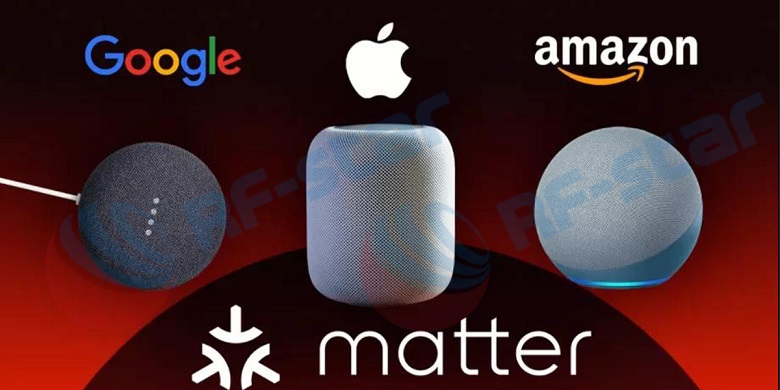
Riepilogo
Materiali di riferimento
Scritto dal consulente senior della stella RF Mr. Wireless (un saggista di We-Media)